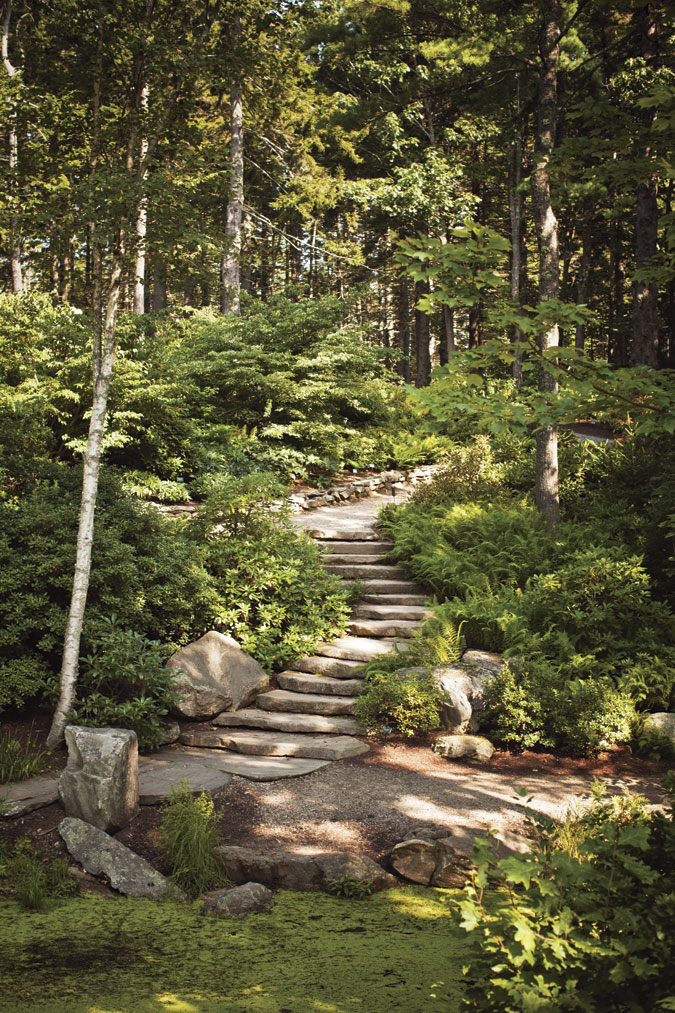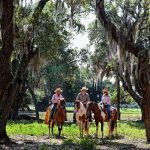At Coastal Maine Botanical Gardens, horticulture guru Bill Cullina celebrates the beauty of the state’s most overlooked landscapes: its woodlands.
Ninety percent of Maine is woodland: That’s the highest percentage of any state, but it’s no surprise to anyone who has driven north on I-95, a straight line cutting through the endless forest on either side. Head east toward the coast, of course, and the landscape changes. But keep going down past Bath to Boothbay, through the gates of Coastal Maine Botanical Gardens, and you’ll see the beauty of the woodlands celebrated in a thousand ways: in a glossy collection of lady’s slippers, a cluster of fern-studded mosses, a Technicolor array of Asian rhododendrons, and more. Here is a reminder that this landscape, a perplexing and often-overlooked venue for most home gardeners, can be more than a drive-by. Even in full sunlight–the gardens are a suite of landscapes, many unshaded by trees–the site offers brilliant ideas for transforming shaded and wooded terrain into cultivated gardens.
For those ideas we can thank the horticulture superstar behind this place. Executive director Bill Cullina has been on staff for just five years, and he’d no doubt be the first to say that this 250-acre wonderland is the product of the many visionaries who came before him. But his ideals are on display: in the use of green design, in the celebration of shade gardens, and in the use of indigenous plants, wildflowers in particular. He worked for the New England Wild Flower Society for many years (serving as director of horticultural research for five of those years), and his Maine gardens are spangled with the varieties he has championed: Solomon’s seal, jack-in-the-pulpit, Canada anemones, Dutchman’s breeches, bunchberries, wintergreen, and more. My own woodland garden has been influenced by Cullina’s books for nearly 20 years, so I jumped at the chance to visit him and to see what more I could learn.
“Ever since I can remember, I’ve been the kind of person who loves to walk in the woods and try to identify things, so I’ve always been drawn to natives,” Cullina explains as we start our walk around the grounds. Here, native plants get a special bed near the brand-new education building–one of the greenest in the state–and they’re used as ornamentals anywhere they fit. Shadbush, blueberries, and summersweet are found in cultivated areas and wilder regions. The meditation garden is calmed by a sea of native ferns.
But to beautify these woods, Cullina also turns to far-flung species, including some of the most luxuriant Epimedium species I’ve ever seen. Garden staffers are in the midst of an application process to accumulate what they hope will be the national collection of these spring-blooming, shade-loving Asian ground covers.
As you walk down a broad path toward the tidal Back River, which runs along the property, exotic weeping conifers give way to native spruce, pine, and fir. There’s a marvelous mass of spikenard. Craggy rock walls are seamed with mosses and spangled with maidenhair ferns. It’s not unlike any typical stretch of wild Maine coastal woodland, except that somehow this one is better. The “somehow” is what Cullina calls “editing”: an essential step for any gardener tackling a woodland habitat. Where standard perennial borders and flower gardens are about building up–adding flowers where there was once only dirt or grass–woodland gardening is as much about taking away: removing seedlings and trees that block views; keeping the moss fairy-tale green by removing distractions such as fallen twigs and dead leaves; and clearing brush to create winding paths through the landscape.
Some of the most striking aspects of the garden’s design are difficult to translate. Few of us have (or could afford to buy) the magnificent granite formations, boulders, and rockwork that form the garden’s “bones.” But most wooded areas around New England have an ample supply of smaller-scale stones and boulders that home gardeners can use to define and accent spaces.
We can also copy the rich black background of organic mulch that you see in beds throughout this property. This double-duty mulch sets off the shapes and colors of the plants, making them pop in muted and dappled light; functionally, it keeps down weeds, conserves moisture, and acts as a fertilizer. (For more on the mulch, see “Bill Cullina’s Advice for Woodland Gardeners,”)
Anyone can plant lush carpets of moss or other shade-loving ground cover, or experiment with several varieties of deciduous bloomers, such as azalea, rhododendron, and mountain laurel. And, although home versions may be less grand, you might also consider including small ponds, dry streams, or rain gardens for water conservation.
Coastal Maine Botanical Gardens first officially opened its gates in 2007. It hasn’t yet filled out, never mind grown the majestic trees that distinguish older properties such as Boston’s Arnold Arboretum. There’s no crystal palace or indeed any public greenhouse. But if you’re looking for inspiration of the more practical sort, this lack of long-established features is a major plus. You’ll find a destination garden being built from scratch, and many of its methods are applicable to ordinary home gardens. And everyone, regardless of space or budget, can follow Cullina’s example by growing native plants (and well-suited, noninvasive imports) in mutually supportive communities, choosing well-adapted and low-maintenance plants, and managing everything organically.
One more advantage of the garden’s youth is the chance to get there before everyone else does. Despite much good press coverage, there’s rarely a crowd, even at the height of the season, and once you go a little distance into those well-managed woods, you may well have the place to yourself.
Be sure to take a notebook and a camera; there’s a lot you’re going to want to remember.
For a roster of events and programs for both children and adults, plus expansive image galleries and links to visitor resources, go to: mainegardens.org





